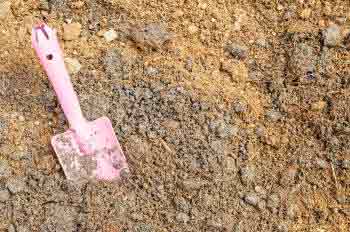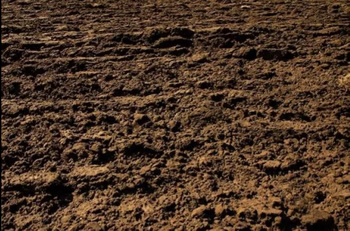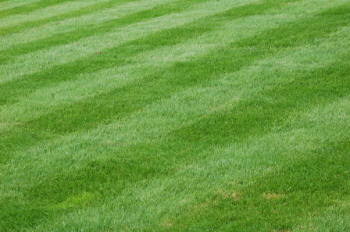There is no science about when a lawn should be watered. It is
normally quite obvious - but often exaggerated. (My lawn mailbox grows
as the grass stops growing!) Much depends upon a wide range of
individual characteristics, such those factors outlined in the list
further down.
Almost all the information given by anyone about watering lawns can
be ignored as far as newly laid lawns are concerned. Whether the new
lawn area has been laid using grass seed or turf it will require
intensive care during the first few months. That is NOT TO SAY
'intensive' watering!
For grass seed to germinate properly, it will
require moisture in the soil. Without soil water, the grass seed will
not germinate - you will have at best a patchy new lawn! The best way to
ensure that grass seed germinates, is to thoroughly water your new area
before you apply the grass seed. This is best carried out over a few
days and ceased at least a day before you actually spread the grass
seed. Your lawn seed bed should be firm enough for you to be able to
walk over without leaving sunken footprints.
After the seed has been sown - depending upon soil moisture - and of
course your local climate - regular watering of the seed is essential to
ensure its continued growth into young grass plants which will
eventually form your lawn.
A light sprinkler is best used rather than a heavy drop type - and
certainly NOT a hose pipe. The young seedlings will need to establish
into the soil without the soil being washed away from their ne root
system. Do NOT water, just for the sake of watering as is often
the case. Too much watering and little drying out can cause disease to
the young lawn seedlings. You should be able to see if there is soil
moisture simply by scraping the top centimeter of soil away - or even
digging your finger into the fine tilth which you should have prepared
prior to seeding.
As the grass grows and starts to need mowing, then watering can be
eased off and a normal watering regime adopted. How much and when will
be determined by reference to the list below.
,
there will not be
such a need for too much soil moisture before laying the turf, for the
turf will require watering after laying to help it bed
into the soil below. Any type of sprinkler is suited to turf for there
is little chance of damaging the protected root system.
The need for additional watering can easily be assessed by gently
lifting the corner of one of the turfs to see if there is adequate soil
moisture below. Once the toots start to penetrate into the soil, than a
visual approach is necessary. Newly laid turf lawns will normally
require watering daily in hot spring, summer or autumn months - if there
is no substantial rain. The watering should be heavy enough to be able
to penetrate down into the root and soil area - not simply dampen the
top grass.
Drying out between watering is essential, so as not to flood the root
system. If patches of turf turn brown it will almost certainly be
because of lack of water - especially where abutting fences, walls and
under trees and shrubs.
You should continue watering for several weeks - maybe a month or so
- and intermittently through the first six months of new turf life. If
the turf was laid in the Autumn, then it should be able to take care of
itself until the following spring.
Whatever the season, be aware that winds dry out grass and soil
surface considerably. Continual wind in the spring is particularly adept
at drying out soil moisture.
- is one of the most
difficult to assess and write about in general terms. Every lawn will be
different, and will require different watering regimes. This can be so
with neighboring lawns as well as being different in geographical areas!
The established lawn in the image above is never watered, receives
public foot traffic, is on easy to dry-out silt soil, never gets any
preferential treatment. It gets mown only when necessary - and never
short. The owner accepts that it will turn brown on many occasions in
the summer - maybe he does not like that, but accepts it! Once it rains,
then it is soon back to a normal healthy green, and because it grows to
well, there is no significant weed growth. The weeds cannot compete with
the strong-growing grasses!
If that does not suit you, and you insist on having a lush velvet
lawn throughout the summer, then water as and when necessary to attain
that utopia. Every lawn is different with differing watering
requirements.
Ideally, your lawn should be watered well just before it starts to
turn dry and brown! Experience only, will determine when this is so.
Otherwise you can have your sprinklers on auto to water if needed or not
- at a given time that is convenient to you.
In short, an established lawn may need watering daily, weekly, or
even monthly dependent upon a host of different circumstances. When you
do water, ensure that there is enough going on to penetrate down into
the root system at least. Far better a good soaking every week with
drying out in between waterings, than a light drizzle every day!
- Some grasses such as Fescues are widely used in UK lawn
mixes, and are generally quite tolerant of drought conditions.
As with Kentucky Blue Grass used in the USA, they grow better on
lighter sandy soils. You would expect grass types that grow on
sandy soils to have a
considerable tolerance to drying out. Many fine ornamental lawns
in the UK have Browntop/Bents in the mixture, and these are not
best equipped to deal with drought - and will require
substantial watering - Bowling greens etc. However, Browntop
grass seed will perform well if only consisting of around 10% of
the total mixture.
-
- Heavy silt or
clay soils - or even good
balanced loam will require less watering than light sandy soils.
The soil type will also determine which grasses will be in your
lawn over time. Fine grasses such as agrostis and some fescue do
better in light soil, and will eventually die out over time in a
heavy soil. Soil acidity also determines which grasses will
grow!
Sandy Soils

Sandy Soils
Sandy soils are those which have a larger proportion of sand particles than they do silt or clay particles. There is is ‘universal’ sandy soil, for they can vary considerably according to the type of sand, geo-location and factors such as organic content. It is possible therefore to have a very light sandy soil or one that verges on the classification of silt soil. Optimally, a soil which is classed as a sandy loam would be ideal. However, we rarely get to choose!
Clay Soils

Clay Soils
Clay soils are possibly the most difficult to improve, but do have a real advantage over sandy soils - so don't start feeling sorry for yourself just yet.
They are sticky when wet, and form hard lumps, which are impossible to break down when dry. In hot weather they form large, deep, cracks. These cracks can rupture roots, and cause moisture loss - which makes the problem even worse. Regular hoeing helps to fill the cracks and forms a surface mulch, which will help retain the soil moisture.
Loam Soils

Loam Soils
The term ‘loam soil’ often bemuses gardeners and is rarely described, but often used with planting instructions for certain plants. Most garden plants it seems prefer to be planted in loam or fertile soil.
There are several definitions as to what constitutes a loam soil, but most agree that loam soils are generally made up of near equal parts of clay, sand and silt particles – generally a smaller ratio of clay particles. Those are the important ingredients that define a loamy soil.
- Generally, the less you mow your low, the
less watering it will require. This may go against the natural
reaction that more foliage demands more water! It is all about
growth. If you cut short and often, the grass plants will need
to put on the growth with the foliage, in order to provide the
roots and the rest of the plant with the nutrients it needs -
hence more rapid growth = more water required. Cut the grass
less in the hot summer, and growth will slow down. It is all
about balance. More cutting - mor watering. Less cutting - less
watering. Try it!
- How important is a green velvety sward to you -
regardless of all else?
- If you accept that browned lawns will return to normal after
a rain shower, then watering becomes less important. If you just
must have a show lawn, then yes, you will need to
water in hot dry summers.
- Surface compaction.
- Surface compaction of the top layer of soil - up to 3in
(75mm) deep, can prevent much of the water from soaking down on
some soils - especially if your lawn is on a slope.
- Lawn cultivation methods.
- How you care for your lawn will have quite a bearing on how
often you will need to water it in the dry summer. A well
maintained lawn, regularly de-thatched, aerated and spiked,
together with annual top dressing, will need less watering when
the going gets tough.
- Lawn Problem Areas
- The areas under trees are best left uncut in the dry weather
- or at many other times of the year. Next to shrub or perennial
borders may also start to brown up as the roots from the borders
compete for available moisture. A drip line along the line of
the lawn edging - laid down in the dip - will be a great help in
areas where there is minimal summer rainfall.
Like so many things in gardening, there is no 'one answer suits all'
to the question of how and when to water a lawn! Nothing will beat
experience. Hopefully the info above will help.


















